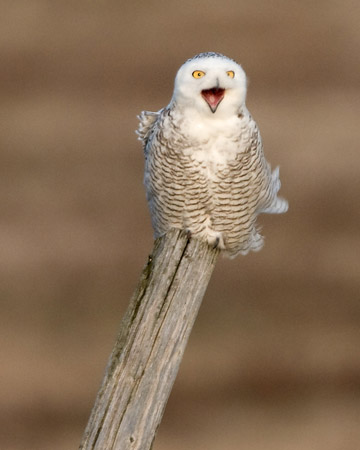The headline was Snowy Owl — A Marine Species?
Surprise!
Snowy owls are famous for eating lemmings but scientists are discovering that their food choices in winter are much more diverse than that.
As part of the International Polar Year, a vast study of the arctic ecosystems that are facing global warming, Canadian scientists radio-tagged snowy owls on Bylot Island and followed their winter dispersal via satellite.
Everyone expected to see the owls move south when the lemming population dropped in the fall. Snowy owls nest with great success and produce many young in summers with high lemming populations. In very low lemming years, they don’t nest at all and any time there’s a short food supply, the owls leave.
The satellite maps told an interesting tale. Not only did the snowies fly south, they also moved north, east and west, and they flew long distances: 500 miles north to Ellesmere Island, 2,000 miles southwest to North Dakota and 2,000 miles southeast to Newfoundland. But the most surprising of all were six adult females who dispersed far out over the frozen sea. They spent the winter on the ice in the dark(*).
Are snowy owls a marine species? What did they eat?
Back in the 1950s a report in The Auk described a snowy owl who perched nearly a mile off shore and captured injured eiders at openings in the ice when lemmings were few on the ground. For now the working theory is that those six owls ate eiders. But scientists need more information to prove it. Were the owls stationed near leads in the ice? Do Inuit hunters see snowy owls out at sea when they go hunting in winter? It’ll be another winter or two before IPY knows for sure.
Meanwhile, this summer was a banner year for lemmings, a great year for raising baby snowy owls, and the best winter in a long time for observing snowies in the U.S. and southern Canada.
Kim Steininger visited Amherst Island, Ontario a couple of weeks ago and brought back some spectacular photos, including this one. Click here to see her photo blog about the snowy owls on Amherst Island.
(photo by Kim Steininger)
(*) By the way, “on ice in the dark” is a fairly good description of Dante’s 9th circle of hell.

Great post on the Snowies. Thank you for passing along the link to the wonderful photos of Kim Steininger, a real treat.
A friend from Massachusetts writes, “Snowy owls have been fairly regular winter visitors on Duxbury Beach (Massachusetts) for
decades. Eiders are extremely common in Duxbury Bay which may explain why they go
there (for the takeout?).”
Hi Kate. The “barn owl” that Barbara had seen here, in Albany, back in November was most likely to have been a snowy owl. The local paper (Albany Times Union) had a piece yesterday (31Dec08) about area sitings since November. They spoke of an irruption of snowy owls this year, but I don’t know if that is a consensus phenomenon. I hope that get a look while it is (they are?) still around.
Does that mean that Dante’s 9th circle of hell is populated by snowy owls?
Robin, your question made me laugh out loud! My guess is there are no snowy owls in the 9th circle. That would make it heaven.